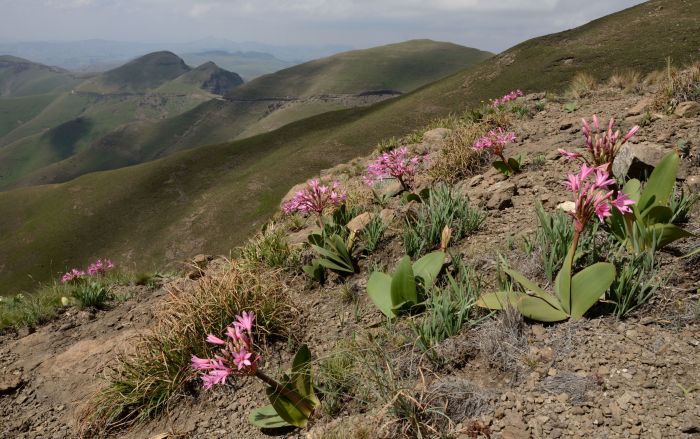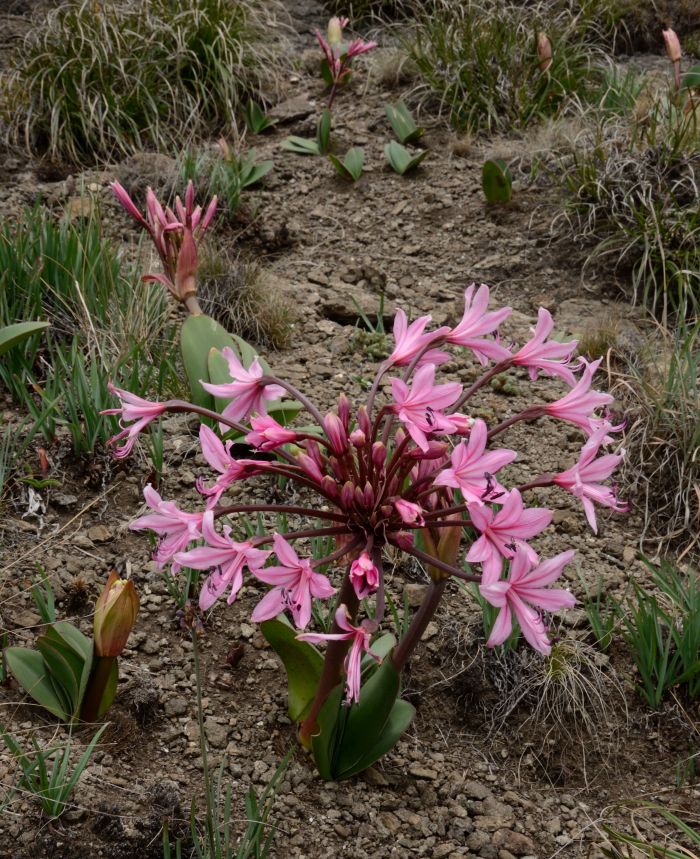Brunsvigia natalensis
Brunsvigia natalensis Baker
Family: Amaryllidaceae
Common names: Natal candelabra flower (Eng.); kandelaarblom (Afr.); umbhola (Zul.)
Introduction
A striking bulbous plant, endemic to southern Africa, with large umbels bearing 30 to 60, attractive, red or pale pink flowers.

Description
Description
A deciduous, summer-growing bulb up to 400 mm tall when in flower. The bulbs are solitary, nearly globe shaped and 50–500 mm in diameter. The 4 to 6, elliptic or oblong leaves are spreading to rarely suberect and more or less contemporaneous with the flowers. They are leathery in texture and 150–300 × 70–120 mm. The inflorescence is a hemispherical umbel, up to 300 mm wide, on an erect to suberect peduncle 180–250 mm long and 15–20 mm wide. The 30 to 60 flowers are spreading and broadly funnel shaped, with pale pink to red tepals, 35–50 mm long. The species flowers in early summer, from October to December.
Brunsvigia natalensis is easily confused with Brunsvigia radulosa, which has similar leaves and flowers, but the latter is distinguished by its broader leaves (100–200 mm wide), longer peduncle (300–500 mm long) and later flowering time (January to February) (Duncan et al. 2016).
Conservation Status
Status
Least Concern (LC), Brunsvigia natalensis is not threatened.

Distribution and habitat
Distribution description
Brunsvigia natalensis is distributed through the eastern interior of southern Africa, from Eastern Cape through KwaZulu-Natal, Free State, Gauteng and Mpumalanga to Limpopo, as well as in Lesotho and Eswatini. The species occurs in grasslands, usually on rocky outcrops.
Derivation of name and historical aspects
History
The genus was named by the Dutch medical doctor, Lorenz Heister, to honor Karl Wilhelm Ferdinand, Duke of Brunswick-Lüneburg. The genus, which comprises ± 18 species, is endemic to southern Africa, with its greatest diversity in the winter rainfall parts of Northern and Western Cape. The specific epithet is derived from the former Natal Province (now KwaZulu-Natal), where the type specimen of the species was collected.
Ecology
Ecology
Brunsvigia species have a diversity of pollinators but no observations of pollinating agent(s) have so far been reported for Brunsvigia natalensis, but we have seen the long-proboscid fly, Philoliche aethiopica (Tabanidae), visiting the species. The seeds are dispersed by wind after the matured inflorescence detaches itself from the peduncle, and tumbles away, scattering seeds.

Uses
Use
Brunsvigia natalensis is traditionally used to ‘strengthen bones of children’ (Pooley, 1998). The species makes a good ornamental plant and is sold in specialist nurseries to enthusiast gardeners.
Growing Brunsvigia natalensis
Grow
Brunsvigia natalensis is suitable to be grown in larger containers of 30–35 cm diam., in a well-drained medium comprising a mix of coarse river sand and composted bark. Watering should be done once a week, or every 10 days in summer, during the growing season. The plants need to be fully exposed to sunlight. The bulbs seem to need exposure to cold winters for flower buds to form.
References
- Archer, R.H & Archer, C. 2005. Brunsvigia radulosa Herb. (Amaryllidaceae). PlantZAfrica. Online. http://pza.sanbi.org/brunsvigia-radulosa.
- Duncan, G., Jeppe, B. & Voigt, L. 2016. The Amaryllidaceae of southern Africa. Umdaus Press, Pretoria.
- Dyer, R.A. 1950. A review of the genus Brunsvigia Heist. [Part 1] Plant Life 6: 63–83.
- Dyer, R.A. 1951. A review of the genus Brunsvigia Heist. [Part 2] Plant Life 7: 45–64.
- Killick, D. 1990. A field field guide to the flora of the Natal Drakensberg. Jonathan Ball and A.D. Donker Publishers, Johannesburg.
- Manning, J., Goldblatt, P. & Snijman, D. 2002. The color encyclopedia of Cape bulbs. Timber Press, Cambridge.
- Pooley, E. 1998. A field guide to wild flowers Kwazulu-Natal and the eastern region. Natal Flora Publications Trust, Durban.
- Pooley, E. 2003. Mountain flowers, a field guide to the flora of the Drakensberg and Lesotho. Natal Flora Publications Trust, Durban.
- Snijman, D. 2005. Brunsvigia Heist. (Amaryllidaceae). PlantZAfrica. Online. http://pza.sanbi.org/brunsvigia.
- Snijman, D.A. & Victor, J.E. 2004. Brunsvigia natalensis Baker. National Assessment: Red List of South African Plants version 2020.1. Accessed on 2021/05/06.
- The South African Bulb Company. Brunsvigia natalensis. Online. https://www.thesabulbcompany.co.za/amaryllidaceae-gallery/ Accessed 06/05/2021.
Credits
Mulweli Maswoliedza & John Manning.
Compton Herbarium
June 2021
Plant Attributes:
Plant Type: Bulb
SA Distribution: Eastern Cape, Free State, Gauteng, KwaZulu-Natal, Limpopo, Mpumalanga
Soil type: Sandy
Flowering season: Early Summer
PH: Acid
Flower colour: Red, Pink
Aspect: Full Sun
Gardening skill: Challenging
Special Features:
Horticultural zones









Rate this article
Article well written and informative
Rate this plant
Is this an interesting plant?
Login to add your Comment
Back to topNot registered yet? Click here to register.